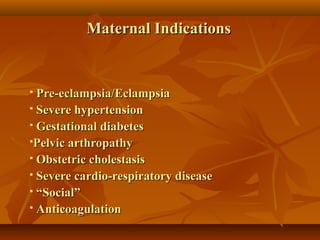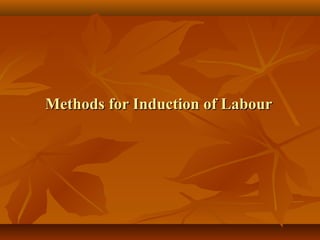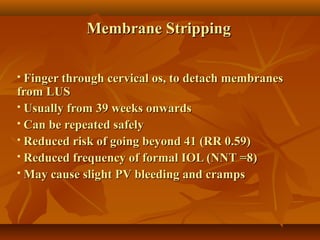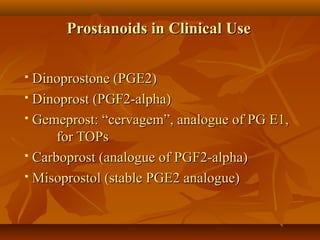Induction of labour
- 1. INDUCTION OFINDUCTION OF LABOURLABOUR Dr Max MongelliDr Max Mongelli Women & Childrens’ HealthWomen & Childrens’ Health Nepean HospitalNepean Hospital
- 2. DefinitionsDefinitions IOL: “Iatrogenic stimulation of uterineIOL: “Iatrogenic stimulation of uterine contractions to accomplish delivery prior to thecontractions to accomplish delivery prior to the spontaneous onset of labour”spontaneous onset of labour” Cervical priming: Interventions designed toCervical priming: Interventions designed to improve the Bishop score without necessarilyimprove the Bishop score without necessarily inducing labourinducing labour
- 3. PrevalencePrevalence USA: frequency has increased from 9.5%USA: frequency has increased from 9.5% to 22.5% over 16 yearsto 22.5% over 16 years Due to availability of better cervicalDue to availability of better cervical ripening agents, more relaxed attitudesripening agents, more relaxed attitudes towards marginal indications fortowards marginal indications for inductioninduction
- 6. Maternal IndicationsMaternal Indications Pre-eclampsia/EclampsiaPre-eclampsia/Eclampsia Severe hypertensionSevere hypertension Gestational diabetesGestational diabetes Pelvic arthropathyPelvic arthropathy Obstetric cholestasisObstetric cholestasis Severe cardio-respiratory diseaseSevere cardio-respiratory disease ““Social”Social” AnticoagulationAnticoagulation
- 8. Fetal IndicationsFetal Indications Post-term pregnancyPost-term pregnancy IUGRIUGR Obstetric cholestasisObstetric cholestasis PROMPROM AmnionitisAmnionitis Fetal demiseFetal demise
- 10. ContraindicationsContraindications Classical C/S scarClassical C/S scar Transmural myomectomy scarTransmural myomectomy scar Placenta or vasa previaPlacenta or vasa previa Active genital herpesActive genital herpes Large cervical fibroidsLarge cervical fibroids MalpresentationMalpresentation Cord presentation or prolapseCord presentation or prolapse Severe IUGRSevere IUGR Abnormal or non-reactive CTGAbnormal or non-reactive CTG
- 11. Pre-Induction AssessmentPre-Induction Assessment Confirm valid indicationConfirm valid indication Exclude contraindicationsExclude contraindications Patient information and consentPatient information and consent Bishop scoreBishop score
- 12. Pre-Induction Assessment:Pre-Induction Assessment: Bishop ScoreBishop Score
- 13. Modified Bishop scoreModified Bishop score
- 14. Significance of Bishop scoreSignificance of Bishop score If Bishop score >5 chance of vaginalIf Bishop score >5 chance of vaginal delivery after IOL same as afterdelivery after IOL same as after spontaneous onset of labourspontaneous onset of labour
- 15. Predictors of Successful IOLPredictors of Successful IOL
- 16. Other Predictors of Successful IOLOther Predictors of Successful IOL MultiparityMultiparity Tall stature ( > 5 ft 5” or 165 cm)Tall stature ( > 5 ft 5” or 165 cm) Normal BMINormal BMI Increasing GAIncreasing GA EFW < 3500 gEFW < 3500 g
- 17. Methods for Induction of LabourMethods for Induction of Labour
- 18. MethodsMethods Membrane strippingMembrane stripping Mechanical methodsMechanical methods AmniotomyAmniotomy OxytocinOxytocin ProstaglandinsProstaglandins
- 19. Membrane StrippingMembrane Stripping Finger through cervical os, to detach membranesFinger through cervical os, to detach membranes from LUSfrom LUS Usually from 39 weeks onwardsUsually from 39 weeks onwards Can be repeated safelyCan be repeated safely Reduced risk of going beyond 41 (RR 0.59)Reduced risk of going beyond 41 (RR 0.59) Reduced frequency of formal IOL (NNT =8)Reduced frequency of formal IOL (NNT =8) May cause slight PV bleeding and crampsMay cause slight PV bleeding and cramps
- 20. Mechanical MethodsMechanical Methods Required for low Bishop scoresRequired for low Bishop scores Ideal when PG’s relatively contraindicatedIdeal when PG’s relatively contraindicated Foley’s catheterFoley’s catheter ATAD catheterATAD catheter LaminariaLaminaria
- 25. AmniotomyAmniotomy Usually when cx is partially dilatedUsually when cx is partially dilated Usually combined with oxytocinUsually combined with oxytocin Colour of amniotic fluid should beColour of amniotic fluid should be notednoted
- 27. Risks of AmniotomyRisks of Amniotomy Fetal hemorrhage if vasa previaFetal hemorrhage if vasa previa Cord prolapse, esp with high headCord prolapse, esp with high head InfectionInfection
- 29. OxytocinOxytocin Almost always after amniotomyAlmost always after amniotomy Given i.v. by infusion pump because of short half-lifeGiven i.v. by infusion pump because of short half-life May take up to 40 mins to reach steady-stateMay take up to 40 mins to reach steady-state concentrationsconcentrations May be stopped once active phase of labour establishedMay be stopped once active phase of labour established Continuous CTG monitoring requiredContinuous CTG monitoring required
- 30. Oxytocin regimesOxytocin regimes Low-dose: less likely to cause hyperstimulationLow-dose: less likely to cause hyperstimulation High dose: short incremental time intervals, noHigh dose: short incremental time intervals, no more than 40 iu/minmore than 40 iu/min Pulsatile regime: boluses at 8-10 min intervals,Pulsatile regime: boluses at 8-10 min intervals, reduced total overall dose of of oxytocinreduced total overall dose of of oxytocin
- 31. Risks of OxytocinRisks of Oxytocin Hyperstimulation / tachysystoleHyperstimulation / tachysystole Uterine ruptureUterine rupture High dose: water intoxicationHigh dose: water intoxication Increased risk of PPHIncreased risk of PPH
- 34. ProstaglandinsProstaglandins Required for low Bishop scoresRequired for low Bishop scores PGE2 gel or pessariesPGE2 gel or pessaries Slow-release systemsSlow-release systems MisoprostolMisoprostol
- 35. Prostanoids in Clinical UseProstanoids in Clinical Use Dinoprostone (PGE2)Dinoprostone (PGE2) Dinoprost (PGF2-alpha)Dinoprost (PGF2-alpha) Gemeprost: “cervagem”, analogue of PG E1,Gemeprost: “cervagem”, analogue of PG E1, for TOPsfor TOPs Carboprost (analogue of PGF2-alpha)Carboprost (analogue of PGF2-alpha) Misoprostol (stable PGE2 analogue)Misoprostol (stable PGE2 analogue)
- 37. Side Effects of ProstaglandinsSide Effects of Prostaglandins
- 38. SE’s of ProstaglandinsSE’s of Prostaglandins HyperstimulationHyperstimulation FeverFever Allergic reactionsAllergic reactions Exacerbation of asthmaExacerbation of asthma
- 39. Other Methods of IOLOther Methods of IOL
- 40. Other Methods of IOLOther Methods of IOL Nipple stimulationNipple stimulation Castor oilCastor oil Cervical vibratorsCervical vibrators AcupunctureAcupuncture SexSex
- 41. Prostaglandins in SemenProstaglandins in Semen PGE : 67.1 mg/LPGE : 67.1 mg/L PGF: 3.2 mg/LPGF: 3.2 mg/L
- 42. Patient’s consent for IOLPatient’s consent for IOL Indication to be explainedIndication to be explained Failure rate and need for C/SFailure rate and need for C/S Possible delay in starting IOLPossible delay in starting IOL Risks to be explained: cord prolapse, fetalRisks to be explained: cord prolapse, fetal distress, PPHdistress, PPH Alternatives to inductionAlternatives to induction Patient info. sheetPatient info. sheet











































